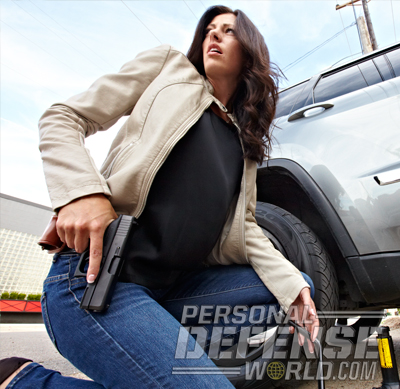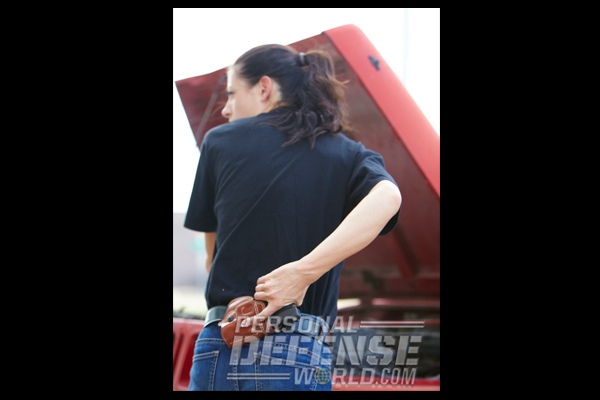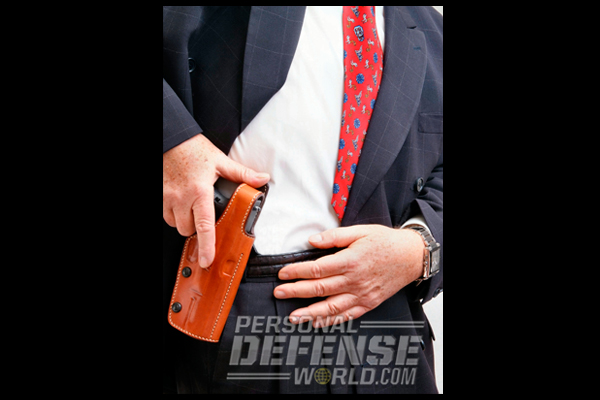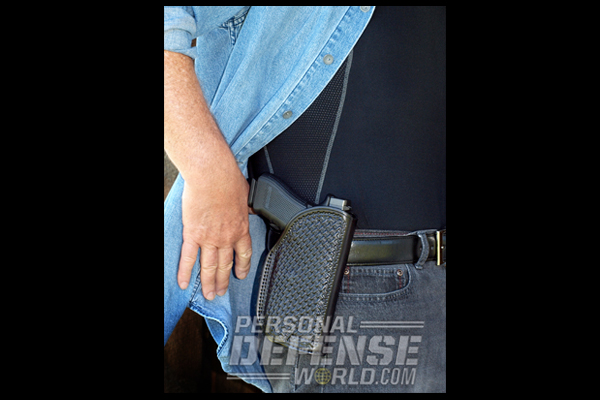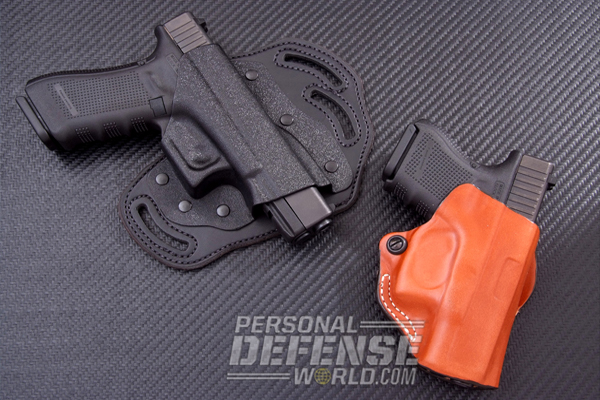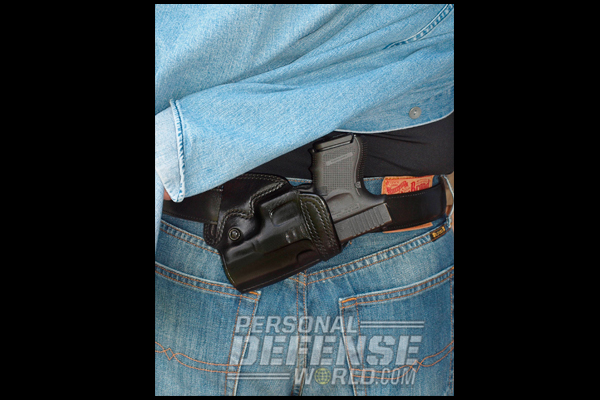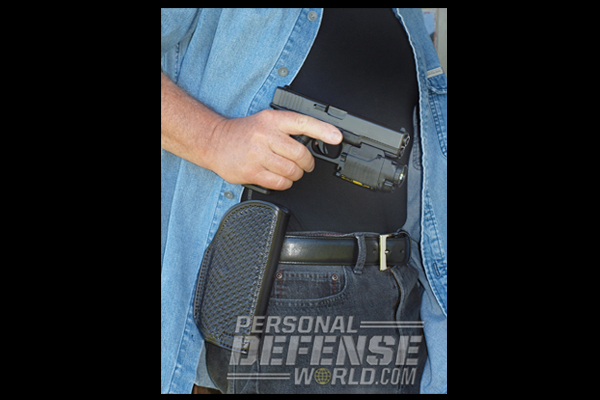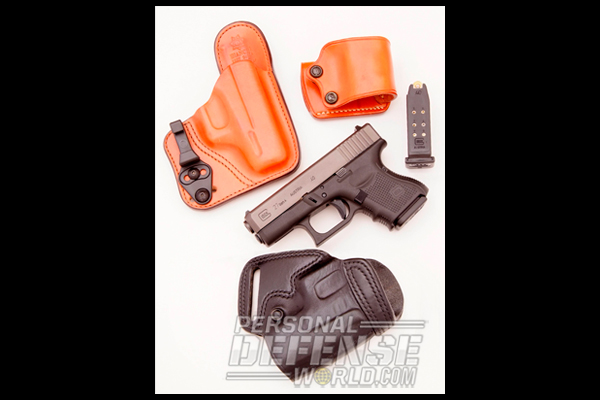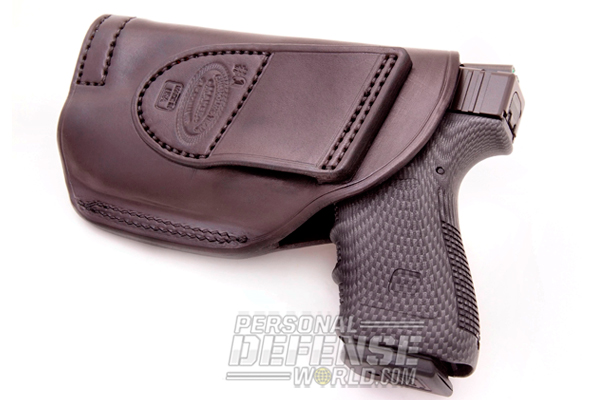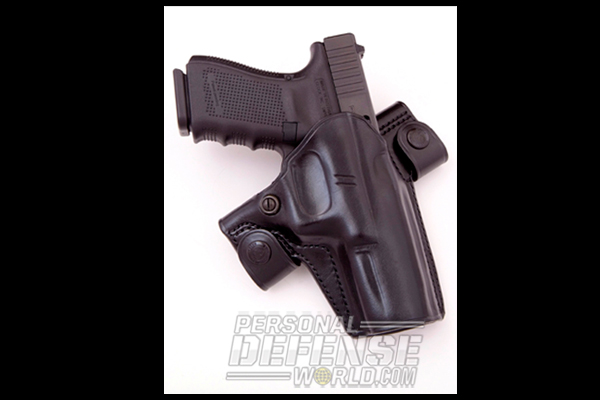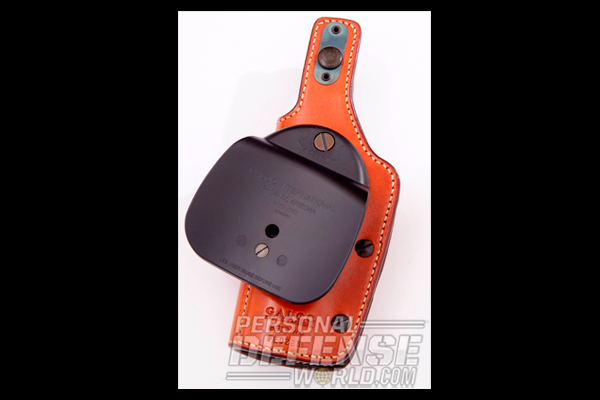Deciding on the purchase of a GLOCK autopistol for concealed carry or personal protection is an undertaking that goes well beyond buying a gun. Even though GLOCKs are among the most reliable and easy-to-handle semi-autos available, the model you choose must be one that you can carry completely concealed on a daily basis. And remember, the operative word in concealed carry is concealed.
WHAT TO CONSIDER:
Outside of military, federal service or law enforcement, where specific makes and models of guns are either issued or required, finding the gun and carry method that best suits an individual is a lot like buying a suit or a pair of shoes—first it has to fit. Before finding the right GLOCK for CCW, you have to think about your build, weight, physical condition—and even your age. As we get older, and as our vision and agility decline, the demands placed upon our bodies by the act of discharging a firearm seemingly increase. Moreover, everyone is different. There is no mold that any one person is going to fit into.
If you are tall, long-waisted, trim and muscular, almost anything goes. Start deducting your physical assets from there, because concealed carry directly impacts every one of them, including your clothing! For example, if you carry a pistol using an inside-the-waistband (IWB) holster—a popular method that provides the most concealment without sacrificing quick access to your firearm—you will need to step up one pant waist size. Add the width of the gun and the holster to your waistline: If you wear 32-inch-waist pants and add an inch of gun and holster (and that’s about the minimum) between your body and your pant waist, you’re going to get “squeezed” unless you allow for more room. If you are short-waisted, neither IWB carry nor a 3 o’clock belt-holster position will work, because in both instances the grips are going to push up into your ribcage when sitting. If you are somewhat overweight, the same problem will occur, and your own body will impair quick access to a sidearm. The solution is a belt or paddle holster worn where it is most comfortable and easiest to consistently retrieve. In some cases, a crossdraw position may be the best option, though crossdrawn pistols are more difficult to conceal. Your weight and build are the first considerations when choosing a proper carry method. If you find carrying a sidearm uncomfortable, it’s likely that at some point you’ll cease to carry it.
Advertisement — Continue Reading Below
After you define your physical parameters, the next consideration is the amount of gun you feel able to handle. To find out, visit a public shooting range that rents out handguns and employs licensed firearms instructors. Before making your purchase, try various calibers and discover the one you can consistently and accurately fire. Start with the smallest-caliber GLOCK, a 9×19, and work your way up to .45 AUTO. Most people will find that their comfort zone is the 9×19 in a short-barreled subcompact, while some may easily excel with the more powerful .40 AUTO or the hard-hitting .45 AUTO. It’s not uncommon to witness a petite woman pick up a subcompact GLOCK 30S (.45 AUTO) and fire it almost nonchalantly, and a strapping 6-foot-4-inch man cringe at the same gun’s recoil. We all respond to recoil differently, and size really doesn’t matter!
Training with a firearm will enhance your ability to understand recoil and make it work for, rather than against, you. However, the ability to handle recoil does not ensure accuracy. A clean miss with a .45 AUTO is no consolation. Find the caliber you can best handle repeatedly and accurately before committing to a purchase. Hand size and strength are also important factors: If a gun is too big for your hand, you won’t be able to grip it firmly. If the gun is too small, the recoil will be harder to manage. Helpful in this respect are GLOCK’s Gen4 (Click Here for a review and video of the Glock 41 Gen4) autopistols, which offer interchangeable backstraps that reduce or increase the grip size and thus the distance to the trigger.
Advertisement — Continue Reading Below
In general, avoid the common temptation to fixate on a preconceived notion about what gun and holster you would like to carry, and work diligently to select the right combination of gun and holster that suits your particular needs and, more importantly, limitations. The general theory for concealed carry is “one gun, one method of carry,” but even that rule has to bend to accommodate changing seasons and wardrobes. The fundamentals come down to four things: gun, caliber, carry method and comfort. With today’s modern concealed-carry holsters, sheer gun size is less pressing a factor than it was in the past. The more pertinent decisions are your choice of caliber (based on skill level and the ability to manage recoil) and the best means of carry in respect to your needs and gun size. The options are numerous and perhaps a little perplexing; rest assured, however, that whatever your individual wants and needs, GLOCK offers a pistol capable of meeting, and exceeding, them.
CARRY A BIG STICK:
That’s the second half of President Theodore Roosevelt’s famous dictum, stipulating what to carry. (The first half, “Speak softly,” addresses how to carry.) A standard GLOCK semi-auto, like the GLOCK 21 SF in .45 AUTO, optimally combines standard magazine capacity with “big stick”-sized stopping power. Smaller guns tend to have a lower magazine capacity and produce more felt recoil.
To carry a standard GLOCK, the user has three traditional choices: a shoulder holster, a belt holster or an IWB rig. While shoulder holsters are popular, they limit what sort of clothing you can wear to properly conceal them. The most comfortable choice is a belt holster, which can best support the weight of the gun and, when worn at the 4 o’clock position (just behind the hip), be well concealed by a long shirt, jacket, sport or suit coat. To use a belt holster, however, means having suitable outer garments to ensure that the gun and holster remain concealed at all times. Outerwear, of course, can feel restrictive in warmer climates or during summer months. A large gun, while generally easier to use and more capacious ammo-wise, is more demanding to carry, requiring dedicated and more elaborate concealment methods.
Advertisement — Continue Reading Below
SMALLER CAN BE BETTER:
The majority of people will find that a compact or subcompact GLOCK is more comfortable to carry concealed. Models are offered in a variety of calibers from 9×19 and .40 all the way up to .45 AUTO. The general dimensions for GLOCK compacts and subcompacts are the same regardless of caliber. (See the chart for dimensions and magazine capacity by model and caliber.) Gen4 compact pistols average 7.28 inches in overall length, 1.18 inches in width and 5 inches in height, and have barrels measuring 4.01 inches long. Average carry weight is 23.65 ounces (with an unloaded magazine). Gen4 subcompacts, which weigh on average 21.71 ounces, average 6.41 inches in overall length, 1.18 inches in width and 4.17 inches in height, and have barrels measuring 3.42 inches long.
To make concealed carry easier, there are specialized holsters (Click Here to read 8 Ways to Covertly Carry Your Weapon) designed to provide the most security with the least amount of added weight or bulk. Many are little more than an open muzzle scabbard to cover the frame of the gun, leaving the barrel exposed. It is also important to consider the cant (angle) of the holster, not only for drawing a gun but also for security. A holster that places the gun at a 90-degree angle (straight up and down) with the barrel protruding can, under some conditions, allow the pistol to be pushed upward and out of the holster when sitting. If gun retention is a concern, consider purchasing a thumb-break-safety holster, which places a strap over the grip, or an injection-molded holster formed to the contours of the gun, which, by engaging the triggerguard, keeps the gun firmly in place. Other injection-molded holsters secure the gun by locking a panel into the ejection port; drawing can only be accomplished by depressing with your gun-hand thumb a thumb-release lock, which toggles the panel. Though precise, the action of drawing from an injection-molded holster is quite natural and easily becomes habitual. Meanwhile, were someone to reach in and attempt to draw from your holster, they’d find themselves thwarted.
Advertisement — Continue Reading Below
Another way to carry a subcompact GLOCK is through the SOB (“small of the back”) approach. The small of the back is a natural curve along which one can place a firearm well out of sight, and it’s easily covered by a shirttail or jacket. The only issues with SOB carry are the fact that the gun is behind you and so less protected, and that, depending on one’s build, sitting with a gun against your back can be uncomfortable. This is less so with small, narrow GLOCK subcompacts.
MINDSET:
Whether one chooses a belt, paddle or IWB holster, the keys to successful concealed carry are comfort, true concealment from view under varying conditions, and the ability to draw and present the gun efficiently each and every time. All three factors impact, and are impacted by, one’s mindset—that is, your attitude toward your weapon and to the world, and the degree of confidence with which you carry. Having the right mindset means maintaining a positive mental attitude, visualizing yourself carrying and using your handgun correctly and constantly practicing. The first and second go almost hand in hand. Having a healthy attitude and self-image as a CCW holder means being able to see in your mind’s eye your gun and holster and their positioning on your body, and being at ease with them. Carrying a gun and a holster should feel no stranger than carrying a smartphone, a wallet or keys.
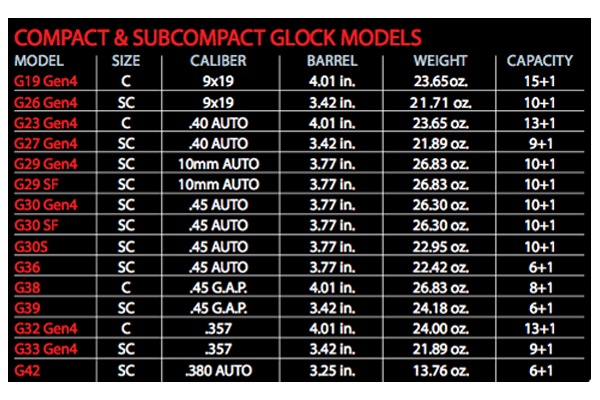
Advertisement — Continue Reading Below
Confidence in your ability to carry your sidearm is just as valuable as knowing how to shoot it. Knowing where your gun is carried and retrieving and presenting it must become instinctive. To that end, consistently practice both your carry method and your draw. You can do so, unloaded gun in hand, in front of a full-length mirror, repeating the necessary movements until your draw from concealment is clean and unimpeded. If you carry using a belt holster covered by a jacket or open shirt, practice sweeping back your jacket or shirt with your hand to give your gun a clean, snag-free field of draw. Do the same if you conceal your firearm under a sweatshirt or a closed jacket. Practice clearing the gun from cover until the movement feels as natural as reaching into a pocket. When using the mirror, don’t look down or for the gun, but rather focus on your reflection and see how smoothly you can accomplish your draw. It’s like practicing a golf swing: Follow-through is what takes you from the holster to getting your gun drawn and placed on target as smoothly and consistently as possible.
These common-sense approaches to developing the proper mindset are just part of the commitment to concealed carry. (Be sure to supplement your personal practice with professional training.) That concealed carry is a significant responsibility—one that requires steady effort and attention—is perhaps the largest lesson of all. There is an old adage, one I’ve come to embrace over time, “Just because you can afford to purchase a race car doesn’t mean you know how to drive it very well.”
For more information on GLOCK firearms, visit: http://us.glock.com/
For information on Holsters, visit:
Advertisement — Continue Reading Below
http://www.desantisholster.com
https://www.galcogunleather.com/
Advertisement — Continue Reading Below
